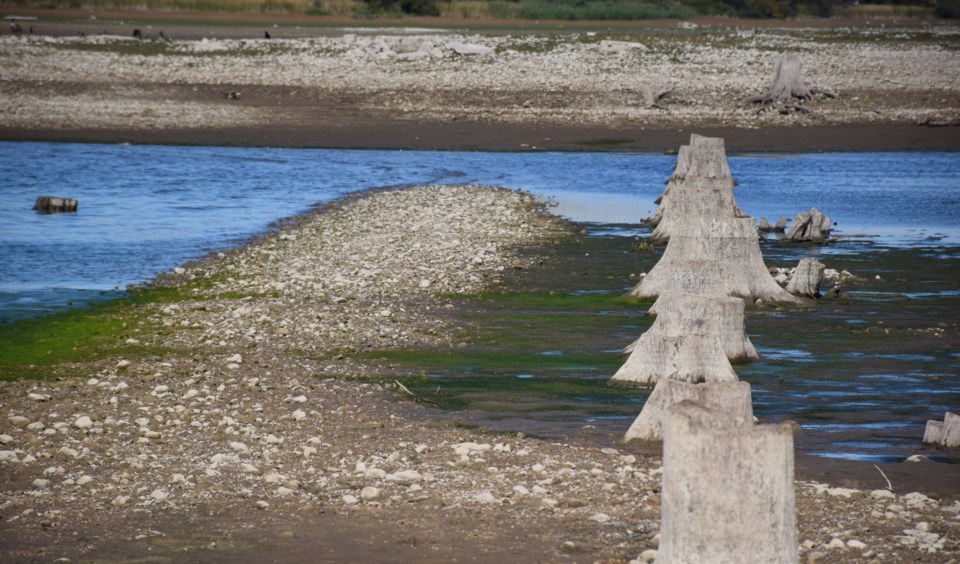Water levels in Guelph Lake were dramatically low six weeks ago. The levels are lower now.
The Grand River Conservation Authority announced Friday it will reduce the amount of water it is releasing from the Guelph Lake reservoir and all seven reservoirs it operates in the Grand River watershed.
The measure is aimed at ensuring that living things, particularly fish stocks in the dammed water bodies are sustained.
But the measure could have an impact on municipal operations downstream, particularly if the watershed is not replenished anytime soon, GRCA manager of communications Lisa Stocco said Friday in an interview.
Among its responsibilities, the agency maintains a specific low-flow water level in streams during low water conditions.
It has been doing that through this very dry period, that started in May and has continued. Above average temperatures have exacerbated the problem.
Similar conditions were experienced, and similar measures taken, in 2007 and 2012.
It may not be possible to maintain that low-flow target. Municipalities have been alerted, and municipal officials will now have to put in place contingency plans in case the dry conditions continue and there is a shortage of water for municipal operations.
While Guelph’s drinking water supply comes from groundwater sources, operations like the wastewater treatment plant use water from the Speed River and Eramosa River. The city has been tightening restrictions on water use since the beginning of the summer, and may have to put further restraints in place.
“If we continue to experience low precipitation then we may not meet those low-flow targets,” Stocco said. “Water managers have been made aware of that, and would be monitoring on their end with respect to those targets and any changes that need to be made on their end.”
A watershed-wide Level 2 condition was issued by the Grand River Low Water Response Team in mid-August, and it remains in place. At this level, water users are requested to voluntarily reduce their consumption by 20 per cent.
The Guelph Lake reservoir was established on a former aggregate site. The water level has become so low that two-meter high piles of gravel that were once completely submerged are now fully exposed. Formerly submerged gravel pit roads and tree stumps are also exposed.
Stocco said the GRCA is not at this point anticipating severe impacts on municipal water taking for drinking water or wastewater operations. But that optimism is based on an expectation of precipitation.
“We are still optimistic that we will continue to receive some precipitation in the form of rain and snow, and will be able to normalize the conditions in our reservoirs,” she said. “Right now we are not anticipating an serious impact to municipal water supplies.”
Water will continue to be discharged from Guelph Lake, but at a reduced level. The reduced flow targets will return to normal once storage in the large reservoirs is back within a normal operating range.
About 500,000 people depend on drinking water from the Grand River, including those in the Region of Waterloo, the City of Brantford and the Six Nations Territory.
About 30 sewage treatment plants discharge treated effluent into the Grand River system. There are 17 treatment plants downstream of the seven GRCA reservoirs.
Wayne Galliher, interim plant manager of Guelph's water services, said the city is not concerned about the water supply at this time.
“Our department continues to monitor conditions of the Eramosa river sub-watershed and other monitoring wells in interest of water supply needs for next year,” he said. “It is hoped that a healthy amount of snowfall/precipitation is received over the winter months and that watershed conditions are replenished to historic levels,” he wrote in an email response.
If low water conditions persist, he added, the city’s outside water use program will be extended into 2017 season, restricting outdoor water uses accordingly.
“That being said, it is important to note that community water demand is greatly decreased at this time, in the absence of lawn watering and other peak seasonal water use tasks commonly driving spring/summer peak demands,” he wrote.
